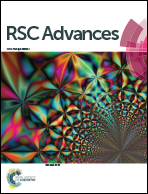Adsorption characteristics of graphene oxide nanosheets on cement†
Abstract
Modifying cement with graphene oxide (GO) nanosheets tremendously improves its mechanical properties but decreases its fluidity. The adsorption characteristics between GO and cement play a pivotal role in the influence on fluidity. In this paper, the adsorption characteristics of graphene oxide nanosheets on cement were investigated using scanning electron microscopy (SEM), total organic carbon (TOC), Fourier transform infrared spectra (FTIR) and XPS analyses. The results show that GO nanosheets have a strong adsorption ability on the cement surface. The adsorption data was best fitted with the Freundlich adsorption isotherm model and described by a pseudo-second order kinetics model. The adsorption process includes a chemical reaction where the –COOH groups on the edge of the GO nanosheets react with metal cations. The adsorption layer thickness of the GO nanosheets on the cement was about 10.16 nm.


 Please wait while we load your content...
Please wait while we load your content...